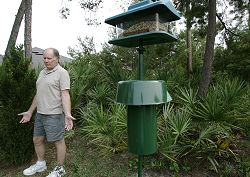|
Article Courtesy of The NewsJournal By Published May 24, 2007 On a recent afternoon, a flock of grackles convened on a 6-foot-tall feeder to eat while cardinals rested on branches nearby. A statue of St. Francis of Assisi, the patron saint of animals in the Roman Catholic Church, sits in the middle of the habitat, keeping watch over the birds, native plants and the gopher tortoise that sometimes visits. The habitat is also home to squirrels, snakes, blue jays and doves, Gray said.
Young said the rats are attracted to the bird and squirrel feeders in the habitat. Neighbors have complained, prompting management to take action, Young said. Gray has been asked to remove the feeders within 30 days, or face fines of $100 a day for violating the neighborhood associations rules, she said. Gray, however, said he refuses to take down the two feeders because the association's rules do not prohibit them. And the "rats" that frequent his habitat are actually meadow voles, he said. "They're the cutest little things," he said. "They're like Mickey (Mouse)." According to the Web site voles.com, meadow voles are small grayish-brown mammals that grow to be about 4 inches long and have a tail of about 1 1/2 inches. Voles are nocturnal, but may come out occasionally during the day. Their diets consist of tubers, grasses, clover and plantains. Gray's sanctuary is one of 80,000 wildlife habitats in the world certified by the National Wildlife Federation, said Roxanne Paul, who coordinates the federation's habitat programs. The federation created its certification process in 1973 to combat disappearing green space by encouraging people to support wildlife with places where animals can find food, shelter and water, and raise their young, Paul said. Certified habitats must feature native plants, birdbaths, shrubs and feeders as part of the landscape, Paul said. Once the habitat is complete, people can send in an application and pictures of the habitat to the federation. Well-created habitats receive a notice of certification that can be displayed on the property. People who have wildlife habitats in their backyards are advised to keep the spaces tidy and avoid direct feeding of animals such as raccoons, she said. The habitats are meant to be a boon for both humans and animals, Paul said. "It's good for the animals but for the people it can be a soothing place," she said. The Audubon Society sponsors a similar program called Healthy Yard. According to its Web site, Healthy Yards are habitats that provide nesting, feeding and shelter opportunities for wildlife. For the 51-year-old Gray, the habitat is his way of giving back to nature and he doesn't plan to take it down. "I just want to be left alone," he said. |
